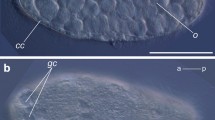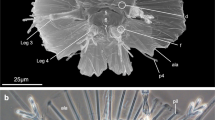Abstract
The musculature of two species of the gastrotrich taxon Dasydytidae, Dasydytes (Dasydytes) goniathrix and Haltidytes crassus, was investigated and described using phalloidin staining, confocal microscopy and computer-aided three-dimensional data analysis. Dasydytidae is a peculiar taxon of freshwater Gastrotricha, containing species that are characterized by different adaptations to a semiplanktonic lifestyle, a rather uncommon feature among primarily benthic Gastrotricha. Like other dasydytid species studied so far, D. goniathrix and H. crassus possess a system of movable cuticular spines with an associated system of somatic oblique and segmented lateral muscles. The presence of other somatic (dorsodermal muscles R1 and R2) and visceral muscles (musculi ventrales, m. ventrolaterales, m. dorsales, m. helicoidales) known from a wide range of gastrotrich species was confirmed. Regarded from a functional perspective, the earlier proposed antagonistic role of oblique muscles (as spine abductors) and segmented lateral muscles (as adductors) is questioned for the species studied herein. Alternatively, our structural and behavioral observations suggest that muscular spine abduction in D. goniathrix is brought about by synergistic contraction of the musculi obliqua and m. laterales, and a passive adduction due to muscle relaxation and elastic recoil of the trunk and cuticle. For H. crassus, we hypothesize active muscular spine abduction by contraction of the musculi obliqua plus the last segment of m. laterales accompanied by severe cuticle deformations close to the spine insertions. Adduction is achieved by cuticle reformation due to elasticity and increase in tissue pressure brought about by muscle action, possibly of enforced dorsodermal muscles. The newly obtained and published muscular data of further gastrotrich species were gathered in a species-character matrix. Based on this data set, a maximum parsimony analysis of representatives of the Dasydytidae has been conducted. According to this analysis, there are three well-supported monophyletic lineages within likewise monophyletic Dasydytidae. The first lineage comprises the taxa Anacanthoderma, Stylochaeta and Chitonodytes, the second comprises Dasydytes, Setopus and Ornamentula, and the third represents the taxon Haltidytes. Relationships between these clades could be resolved but are only weakly supported. The new phylogenetic hypothesis is used to reconstruct the ancestral character pattern and to infer possible evolutionary transformations within the Dasydytidae.










Similar content being viewed by others
References
Abramoff MD, Magelhaes PJ, Ram SJ (2004) Image processing with imageJ. Biophotonics Int 11:36–42
Balsamo M, Todaro MA (2002) Gastrotricha. In: Rundle SD et al (eds) Freshwater Meiofauna: biology and ecology. Backhuys Publishers, Leiden, pp 45–61
Balsamo M, d’Hondt J-L, Pierboni L, Grilli P (2009) Taxonomic and nomenclatural notes on freshwater Gastrotricha. Zootaxa 2158:1–19
Hochberg R (2005) Musculature of the primitive gastrotrich Neodasys (Chaetonotida): functional adaptations to the interstitial environment and phylogenetic significance. Mar Biol 146:315–323
Hochberg R, Gurbuz OA (2007) Functional morphology of somatic muscles and anterolateral setae in Filinia novaezealandiae Shiel and Sanoamuang, 1993 (Rotifera). Zool Anz 246:11–22
Hochberg R, Gurbuz OA (2008) Comparative morphology of the somatic musculature in species of Hexarthra and Polyarthra (Rotifera, Monogononta): its function in appendage movement and escape behavior. Zool Anz 247:233–248
Hochberg R, Litvaitis MK (2000) Phylogeny of Gastrotricha: a morphology-based framework of gastrotrich relationships. Biol Bull 198:299–305
Hochberg R, Litvaitis MK (2001a) A muscular double helix in gastrotricha. Zool Anz 240:61–68
Hochberg R, Litvaitis MK (2001b) The musculature of Draculiciteria tesselata (Chaetonotida, Paucitubulatina): implications for the evolution of dorsoventral muscles in Gastrotricha. Hydrobiologia 452:155–161
Hochberg R, Litvaitis MK (2001c) The muscular system of Dactylopodola baltica and other macrodasyidan gastrotrichs in a functional and phylogenetic perspective. Zool Scripta 30:325–336
Hochberg R, Litvaitis MK (2001d) Functional morphology of muscles in Tetranchyroderma papii (Gastrotricha). Zoomorphology 121:37–43
Hochberg R, Litvaitis MK (2003) Organization of muscles in Chaetonotida Paucitubulatina (Gastrotricha). Meiofauna Mar 12:47–58
Hummon WD (1974) Intertidal marine gastrotricha from Colombia. Bull Mar Sci 24:396–408
Kånneby T (2011) New species and new records of freshwater Chaetonotida (Gastrotricha) from Sweden. Zootaxa 3115:29–55
Kånneby T, Todaro MA, Jondelius U (2012) A phylogenetic approach to species delimitation in freshwater Gastrotricha from Sweden. Hydrobiologia 683:185–202
Kieneke A, Martínez Arbizu P, Riemann O (2008a) Body Musculature of Stylochaeta scirtetica Brunson, 1950 and Dasydytes (Setodytes) tongiorgii (Balsamo, 1982) (Gastrotricha: Dasydytidae): a functional approach. Zool Anz 247:147–158
Kieneke A, Riemann O, Ahlrichs WH (2008b) Novel implications for the basal internal relationships of Gastrotricha revealed by an analysis of morphological characters. Zool Scripta 37:429–460
Kisielewski J (1991) Inland-water Gastrotricha from Brazil. Ann Zool 43(2):1–168
Leasi F, Todaro MA (2008) The muscular system of Musellifer delamarei (Renaud-Mornant, 1968) and other chaetonotidans with implications for the phylogeny and systematisation of the Paucitubulatina (Gastrotricha). Biol J Linn Soc 94:379–398
Leasi F, Todaro MA (2009) Meiofaunal cryptic species revealed by confocal microscopy: the case of Xenotrichula intermedia (Gastrotricha). Mar Biol 156:1335–1346
Leasi F, Rothe BH, Schmidt-Rhaesa A, Todaro MA (2006) The musculature of three species of gastrotrichs surveyed with confocal laser scanning microscopy (CLSM). Acta Zool 87:171–180
Lee D-C, Bryant HN (1999) A reconsideration of the coding of inapplicable characters: assumptions and problems. Cladistics 15:373–378
Maddison W P, Maddison DR (2011) Mesquite: a modular system for evolutionary analysis. Version 2.75 (http://mesquiteproject.org)
Maddison DR, Swofford DL, Maddison WP (1997) NEXUS: an extendible file format for systematic information. Syst Biol 46:590–621
Melone G, Ricci C (1995) Rotatory apparatus in Bdelloids. Hydrobiologia 313/314:91–98
Page RDM (2001) NDE—nexus data editor version 0.5.0 [Computer software]. Available via http://taxonomy.zoology.gla.ac.uk/rod/rod.html
Rasband WS (1997–2007) ImageJ. U.S. National Institutes of Health, Bethesda, Maryland, USA, http://rsb.info.nih.gov/ij/
Remane A (1936) Gastrotricha. In: Bronn HG (ed) Klassen und Ordnungen des Tierreiches, 4. Band: Vermes II. Abteilung Askelminthes, Trochhelminthes. Akademische Verlagsgesellschaft, Leipzig, pp 1–242
Rieger R, Tyler S (1979) The homology theorem in ultrastructural research. Am Zool 19:655–664
Rothe BH, Schmidt-Rhaesa A, Kieneke A (2011a) The nervous system of Neodasys chaetonotoideus (Gastrotricha: Neodasys) revealed by combining confocal laserscanning and transmission electron microscopy–evolutionary comparison of neuroanatomy within the Gastrotricha and basal Protostomia. Zoomorphology 130:51–84
Rothe BH, Kieneke A, Schmidt-Rhaesa A (2011b) The nervous system of Xenotrichula intermedia and X. velox (Gastrotricha: Paucitubulatina) by means of immunohistochemistry (IHC) and TEM. Meiofauna Mar 19:71–88
Ruppert EE (1991) Gastrotricha. In: Harrison FW, Ruppert EE (eds) Microscopic anatomy of invertebrates, Aschelminthes. Wiley, New York, pp 41–109
Schwank P (1990) Gastrotricha. In: Schworbel J, Zwick P (eds) Süßwasserfauna von Mitteleuropa, Band 3, Teil 1. Gustav Fischer, Stuttgart, pp 1–252
Strong EE, Lipscomb D (1999) Character coding and inapplicable data. Cladistics 15:363–371
Swofford DL (2002) PAUP*—phylogenetic analysis using parsimony (*and Other Methods). Version 4. [Computer software and manual]. Sinauer Associates, Sunderland, Massachusetts
Todaro MA (2012) Gastrotricha World Portal, webpage, last update 04 Jan 2012 (http://www.gastrotricha.unimore.it/)
Wägele JW (2005) Foundations of phylogenetic systematics. Verlag Dr. Friedrich Pfeil, München
Wanninger A (2007) The application of confocal microscopy and 3D imaging software in functional, evolutionary, and developmental zoology: reconstructing myo- and neurogenesis in space and time. In: Mendez-Vilas A, Dias J (eds) Modern research and educational topics in microscopy. Formatex, Badajoz, pp 353–361
Zelinka K (1889) Die Gastrotrichen. Eine monographische Darstellung ihrer Anatomie, Biologie und Systematik. Z wiss Zool 49:209–384
Acknowledgments
Many of the data presented in this publication are results of a practical laboratory module and the bachelor thesis of AO. We want to thank Wilko Ahlrichs and Olaf Bininda-Emonds (University of Oldenburg, Germany) for providing laboratory space and further scientific infrastructure during that time. Many thanks go as well to the head of our institute, Pedro Martínez Arbizu, for providing an uncomplicated access to the confocal microscope any time and for further ideational and substantial support. Rick Hochberg and a second anonymous reviewer did a great job on improving the first version of this manuscript. Additional editorial remarks by Thomas Bartolomaeus are also acknowledged. AK is supported through a postdoctoral appointment of the Senckenberg Research Institute and Natural History Museum.
Author information
Authors and Affiliations
Corresponding author
Additional information
Communicated by T. Bartolomaeus.
Electronic supplementary material
Below is the link to the electronic supplementary material.
Rights and permissions
About this article
Cite this article
Kieneke, A., Ostmann, A. Structure, function and evolution of somatic musculature in Dasydytidae (Paucitubulatina, Gastrotricha). Zoomorphology 131, 95–114 (2012). https://doi.org/10.1007/s00435-012-0152-5
Received:
Revised:
Accepted:
Published:
Issue Date:
DOI: https://doi.org/10.1007/s00435-012-0152-5




